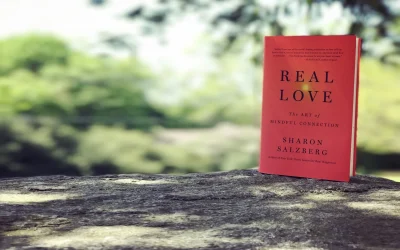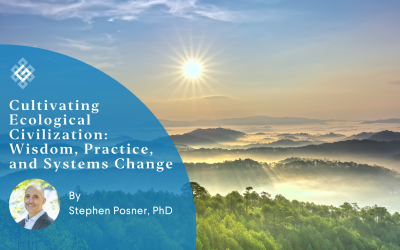The Garrison Institute is pleased to announce the appointment of Christa Tinari as the new Director of our Contemplative-Based Resilience (CBR) Project.
“We are very excited to welcome Christa to the Institute and to our team,” says Brian Gallagher, Interim Executive Director. “She brings a wealth of experience regarding the science of contemplation in the service of human well-being, and is the ideal leader to grow and deepen the impact of our CBR program.”
To learn more about Christa Tinari and the future of this program, please continue reading:
Q: Christa, what has been your journey to the Garrison Institute?
My journey to the Garrison Institute is connected to my personal journey to contemplative practice and my career in Peace Education. In 1995, I was studying Psychology in college when I was impacted by an act of violence. I was overcome with very strong emotions and sought ways to heal. My search led me to attend a 1997 conference on Nonviolence in San Francisco where The Dalai Lama was a keynote speaker. I attended workshops with Alice Walker, Linda Lantieri, Daniel Goleman, and other amazing people. Sharon Salzberg (who would later co-create the CBR project with Garrison Institute co-founder Diana Rose) was also a presenter and I bought her book on Lovingkindness.
The following year I went on a retreat with Thich Nhat Hanh and that’s what really started my mindfulness practice. I’d been raised Catholic, and although I left the tradition as a teen, I’d been inspired by the ideals of service, forgiveness, and radical love. I discovered that mindfulness helped me cultivate the awareness and emotional balance I needed to more fully live out these ideals.
Christa welcomes leaders of philanthropic and human service organizations interested in CBR to contact her directly at christa@garrisoninstitute.org.
Q: How did this path turn into a career?
Just a few years later, I began graduate school in International Peace Studies and Conflict Resolution at American University. I interned with Nonviolence International and The Fellowship of Reconciliation and learned a lot about social movement organizing. I also had a teaching internship at Woodrow Wilson High School.
The first week I was there, two students were shot and killed. That tragedy cemented my commitment to work in violence prevention. I made a commitment to bring the methods of peacemaking to as many people as possible. It became clear to me that the quest for peace would need to include personal healing which is a necessary step in breaking the cycle of violence. But it would also need to address the ways in which personal violence is often a result of social and systemic inequality that perpetuates injustice.
Q: What is your experience working with human service professionals?
At the beginning of my career I did a lot of direct service work. I worked for a domestic violence agency and led a program for juvenile offenders. I became a crisis intervention specialist and school counselor. After 9/11, I joined efforts to organize Stop the Hate events and to support targets of biased-based hate.
I loved that work, but it was emotionally and psychologically draining and I was sometimes overcome by anxiety. Although I had a contemplative practice, degrees in Psychology and Conflict Transformation, I hadn’t yet learned about the impact of vicarious trauma and the effects it was having on my emotional and physical well-being. It wasn’t until later that I gained a neurobiological understanding of stress which helped me regulate my nervous system and respond to my own needs.
After a decade of direct service work, I created PeacePraxis, a consultancy through which I worked with educational organizations and nonprofits working for the social good. I did a lot of training and curriculum writing, program development, implementation and evaluation. I co-authored a book and brought social-emotional learning to schools. Time and time again, people kept asking, “Why didn’t I learn this earlier in my life? This information and these skills would have saved me from so much pain!”
Prior to coming to the Institute, I worked with the Social, Emotional and Ethical Learning Program at the Center for Contemplative Science and Compassion-based Ethics at Emory University. In 2019, The Center launched the SEE Learning program in India to a global audience. After a whirlwind year of international travel, we developed online programming during the covid lockdowns. SEE Learning has now reached millions of students and educators in over 40 countries.
Q: What interested you in CBR?
CBR recognizes the incredible value that direct service workers contribute to social transformation. It was one of the first programs to bring contemplative practices to helping professionals, specifically to address their well-being. The goal of CBR is to empower helpers to take care of themselves – to increase their resilience and decrease burnout – to be well, so that they can serve well. CBR can help participants get back in touch with the energy and sense of purpose that brought them to their life’s calling.
CBR includes a unique combination of mindfulness practices and compassion meditation, trauma-informed mindful movement and body awareness, and education on the psychology and neurobiology of stress. All of the tools we offer in CBR are practical, simple, and backed by scientific evidence that suggests they are effective in building resilience to stress.
In CBR, we introduce a nuanced understanding of the difference between empathy and compassion. Most people in the helping professions experience deep empathy towards those who are suffering. Empathy is a human response that connects us deeply with others. However, when someone experiences the suffering of another person as their own, this leads to empathic distress. This can cause overwhelm and burnout. Compassion – cultivated towards others and oneself – is the solution to this problem. Engaging in compassion practices motivates us to help others but can protect us from the feelings of helplessness and psychological and emotional impacts of secondary stress.
Q: How do you see the future of CBR?
I’m really impressed with what CBR has done so far and the ways in which it has reached different populations. It started off early on as the Wellness Project and served domestic violence professionals. Then it became the Transforming Trauma initiative which focused on humanitarian aid workers. These programs were delivered as retreats. More recently CBR launched an app on the Awaris platform, as well as a video series.
Now, we’re hoping to reach new populations and we’re building a full menu of in-person and online programs that include webinars, courses, and retreats. I’m very happy to be with the Institute at this point in time when CBR is needed more than ever, and we are developing new ways to deliver this impactful work. As Director, I’m committed to getting the program to the people who need it the most!
How can you help?
We’d like to reach first responders, healthcare workers, human service workers, counselors, case workers, those in social services, and others who experience vicarious trauma through their work. If you’re an organizational leader who feels that your staff could benefit from CBR, please contact me. We also welcome your financial support.



